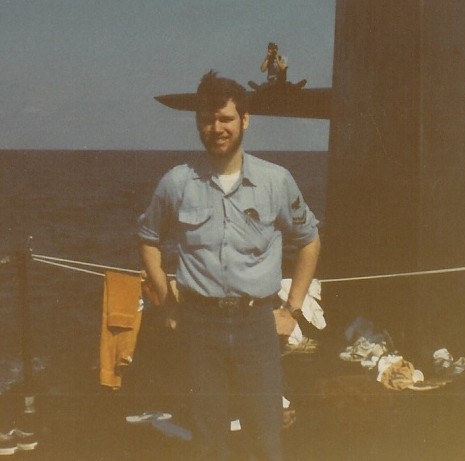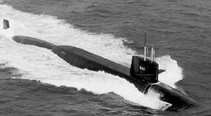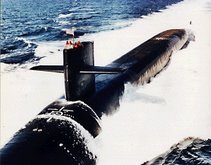Thursday, December 22, 2005
Navy Payments for Katrina Loss Questioned
WASHINGTON -- A Navy plan to pay Gulf Coast shipbuilders about $1.7 billion for losses related to damages and construction delays from Hurricane Katrina may overstate the actual costs and could dampen efforts to collect insurance payments, according to a Congressional report.
The nonpartisan Congressional Research Service said Northrop Grumman may be able to collect insurance claims for future increased costs related to labor and overhead. If the government pays now, the report said, the company will have little incentive to negotiate with insurers for those payments.
The Northrop Grumman shipyards in question seem to include those with a recent record of poor performance as I noted here and CDR. Salamander noted here and here. The amounts requested appear to have been all over the place - from the same article:
Navy Assistant Secretary John Young initially requested $2.7 billion to restore the shipyards, replace lost material and get workers back on the job. The Pentagon later asked for a total of $6.6 billion, including $2 billion for shipbuilding. Congress cut the Defense Department funding back to about $5.8 billion in the bill.
The congressional researchers took issue with the Navy's argument that the money is needed immediately, and suggested the government should wait for more accurate cost estimates. Delaying the request, the report said, could also allow insurance negotiations to proceed.
Could the billions requested be to prop up failed shipyards and shipbuilding programs in the form of economic relief that insurance will pay a fair portion of anyway?
Monday, December 19, 2005
Arctic Oil and Submarines
WASHINGTON -- Billions of dollars in federal funds targeted for Connecticut defense firms will sit in limbo as the Senate wrestles over the contentious issue of Arctic oil drilling.
Democrats, including Sen. Joe Lieberman of Connecticut, are threatening to filibuster the defense appropriations bill as Congress rushes to finish its work before Christmas. They object to language added to the bill by Republicans that would open Alaska's Arctic National Wildlife Refuge to oil drilling.
Connecticut Democrat lawmakers are in a difficult position, do they unite behind their party and filibuster the $453 billion military spending bill over an Arctic oil drilling provision, or let it pass in favor of their Connecticut constituents in the defense industries.
Both CT Democrat Senators Joe Lieberman and Christopher Dodd spoke out against the ANWR oil drilling provision in the current defense bill. Whereas, Republican Rep. Rob Simmons said this about the defense bill "The bill provides some relief for the unique work force at Electric Boat. I will continue to work in Congress to ensure that good-paying shipbuilding jobs remain in Connecticut." Simmons district includes the Electric Boat Groton shipyard.
In the bill Electric Boat would receive $2.5 billion for an additional Virginia Class nuclear attack submarine and $15 million for the design of a new attack submarine. Electric Boat had recently announced a planned layoff of 2,400 shipyard workers in 2006.
Perhaps if we started purchasing diesel submarines from Europe Lieberman and Dodd could find their way to backing the ANWR provision. Although I don't think ANWR oil drilling belongs in a defense bill I do believe we need a better energy policy than the current no new drilling, no new refinery environmentalist lock. Speaking of energy, the defense bill also includes $3.75 million for Fuel Cell Energy in Danbury CT to develop a molten carbon clean fuel cell generator.
Update 12/20/05: Rhode Island lawmakers add their disapproval to the Defense bill's ANWR provision with Sen. Jack Reed (D) saying "It is a cynical gesture that has delayed approval of this important bill". The bill is important because R.I. firms could gain more than $50 million in the defense bill so I suspect the RI lawmakers to approve the spending bill despite their complaints.
Update 12/21/05: Sen. Ted Stevens (R- Alaska) lost his bid to attach ANWR oil drilling provision to the Defense bill.
Wednesday, December 14, 2005
Sumatra tsunami of Dec 2004 legacy

Sumatra Tsunami (Graphic Source: USGS)
From the Sydney Morning Herald "Shocked scientists find tsunami legacy: a dead sea"
A "DEAD zone" devoid of life has been discovered at the epicentre of last year's tsunami four kilometres beneath the surface of the Indian Ocean.
Scientists taking part in a worldwide marine survey made an 11-hour dive at the site five months after the disaster.
They were shocked to find no sign of life around the epicentre, which opened up a 1000-metre chasm on the ocean floor.
Instead, there was nothing but eerie emptiness. The powerful lights of the scientists' submersible vehicle, piercing through the darkness, showed no trace of anything living.
The south Asian tsunami claimed more than 270,000 lives and created one of the largest relief efforts in recent history. A year later, the "fast acting" UN is having its second meeting on setting up a regional tsunami warning system. Gallery of tsunami photo can be found here.
Some scientists think that a US east coast mega tsunami is possible. Maybe someday the US eastern seaboard could its own tsunami warning system.
Sunday, December 11, 2005
Submariner Santa (SS) - Update
I started the previous post by saying that it was the USS Charlotte's (SSN 766) recent visit to the North Pole that had me wondering "Does Santa wear Dolphins". One proud parent of an SSN766 crew member had this to say in an email to me:
"My son went to the North Pole on the Charlotte. I asked him about Santa, but all he would tell me was "Loose lips sink ships." I could tell from the tone of his voice, he saw something. Maybe some day it will be declassified, and he can tell me all about it. "
I hope this person doesn't mind I quoted their email but it appears Santa has some sort of "need to know" clearance and may be working on an upcoming operation (NORAD video link). It appears submarine sailors know something but are keeping it silent while others service members aren't so silent.
Additional pictorial evidence of Submariner Santa or Mr. (SS) has shown up in my email box as well.

Santa has silver Dolphins?
This new evidence has raised a bit of a controversy. It appears Santa's Dolphins are silver making him a "white hat" enlisted type although some may question this observation. This doesn't reflect poorly on those who wear gold dolphins, it just means Santa has a sense of humor about his own chain of command. Why else would he send his helpers to Santa's North Pole Academy which even has a Moscow branch. We all know that Academy graduates qualified in submarines usually wear the gold Dolphins.
There you have it a Secret Santa who may wear silver dolphins and not gold. To steal a line "we present the facts you decide".
Happy Holidays - LL
Friday, December 09, 2005
Does Santa wear Dolphins?
A recent photo I saw at TheSubReport of the USS Charlotte (SSN 766) at the North Pole combined with the approaching holidays has got me wondering; “Does Santa wear Dolphins?”.
Using Lubber’s Line investigative tools, google, beer and memory, I decided to document my suspicions. The accumulative evidence is overwhelming:
First take the coincidence of names, there is a Submarine named the SANTA Fe (SSN 763) and a famous Submarine harbor in Guam located in the village of SANTA Rita. Could these names be in honor of that golly old elf?
Second is the fact that submarines are constantly visiting the North Pole and are sometimes greeted by St. Nick himself. The pictorial evidence (Photos Source: US Navy) below is ill refutable.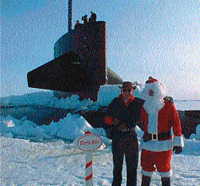
Santa Greeting the USS Hawkbill (SSN 666) 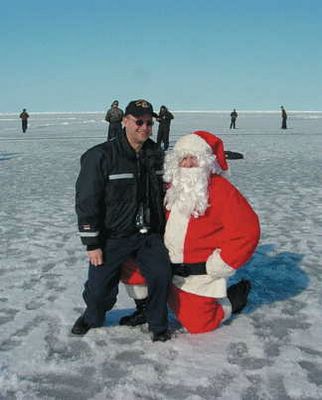
Navigator of the USS Connecticut (SSN 21) asking Santa for a new gyrocompass.
(Elves can be seen in background)
Santa Claus was the first to celebrate the arrival at the North Pole of the NAUTILUS and there has even been foreign news reports of other Subs visiting Santa.
Occasionally Santa will return the favor, come down from the northern latitudes, and visit his bubblehead friends. Although in some cases he should get the proper clearances first.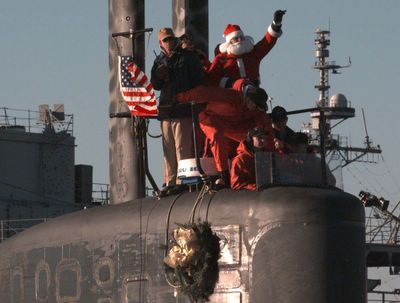
Not to miss a good sale Santa hitches a ride on one.
Submariner's even write poetry about Santa visits.
Then there are those unique Santa attributes:
Never heard or seen, in the dead of night he uses stealth to deliver his payload.
He can climb up bridge trunk or the inside of a chimney with ease.
He is rarely seen out of uniform with spit shined boots and a distinctive red poopy suit.
Mid-rats seems to be his favorite meal.
His year is filled with intel ops, checking on naughty and nice activities.
If you shave his beard and give him a crew cut he looks like the COB.
At the end of year the elves get grumpy and overworked in preparation of a ritual they've nicknamed ORSE (Old Red Suit's Excursion) or the alternate TRE (Tree Receptacles Evolution).
But the true clincher for me was the fact that submarine escape training required you to learn the Santa song and sing Ho, Ho, Ho all the way to the surface.
Santa's new red submersible safety suit (Ho, Ho, Ho)
I hope all this evidence is convincing because, some day, when my young son asks me the inevitable question, "Dad is there really a Santa?" being honest I'll have to say:
"I can nether confirm or deign the existence of Santa, but if he is real, I think he wears Dolphins".
Thursday, December 08, 2005
Dec 7, 1941 - A Submariner's Response
Over four months later on April 18, 1942 the response came in the form of the Doolittle Raid on Tokyo.
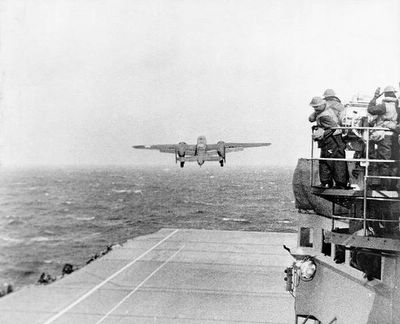
USS Hornet launch of B-25 for the Doolittle Raid on Tokyo
It was an WWI submariner Capt. Francis S. Low (former commander of the S-12) who conceived of the idea to takeoff heavily laden bombers from the deck of an aircraft carrier. Captain Low got the idea a month after Pearl Harbor, when he saw Army bombers perform simulated bomb runs over the outline of a carrier deck painted on a runway. An example of intuition and creative thinking by a submariner.
An Army bomber flown off a Navy carrier conceived by a pig boat sailor and executed three months after the idea is presented, now that's innovative warfighting.
Tuesday, December 06, 2005
Between Two Worlds – Surface/Submerged
Surfaced heading for the deep:
A person at sea can feel insignificant or small compared to the vastness of the ocean’s expanse and depths. I had such a feeling aboard the USS Alabama SSBN 731 on a cold and clear midwinter’s night in 1985.
We were somewhere near the end of a progression of builder’s trials before commissioning, at sea, on the surface and off the Southern New England coast. Having just come off watch I requested permission to go to the bridge for some air. With permission granted, I climbed up to the bridge and into a different world.
On the Bridge, the temperature was significantly colder than down below in the control room. The below freezing temps weren’t uncomfortable but invigorating after a long maneuvering watch on the Radar and ESM. Once topside I scanned the horizon west of us for the fishing trawlers I had tracked while on watch earlier. We had passed a small group of trawlers around the 50+ fathom curve, probably fishing the moraines and ledges that run for miles out beyond Block Island. The only sign I could see was a single white masthead light flickering out of sight as we moved away and further towards our dive point.
It was a nearly clear moonless night and the canopy of stars seemed to stretch to infinity. It’s hard to describe the extent of the night sky when there’s no city or street lights to obscure or diminish the view, but if you have ever been far out at sea or in the wilderness at night you know what I mean. The only other light source outside the ship was the blue-green glow of millions of bioluminescent sea creatures disturbed by the boat’s movement through the ocean. A glowing greenish frothing wake trailed off behind us in a gentle arch towards the western horizon. Occasionally the bow pressure wave would produce miniature flashes as the ships motion forward excited these dinoflagellates.
Other than orders here wasn’t much conversation going on between the bridge watch standers. Everyone seemed to be just taking it all in.
What struck me was the contrast, in one moment I could step back into the cold, feel small, and alone surrounded by the vastness of the ocean and night sky. The next I could move over the bridge trunk, feel the warm air rising up, hear my shipmates busy below and feel the power of the ship pushing through the sea. A cocoon of steel and technology soon to disappear into the depths of the cold vastness of the sea.
At that moment, I was a lifer ready to sign the re-enlistment papers for another hitch.
Submerged looking to the surface:
I heard that the Navy did a study a while back and found that colors or the lack of can have an effect on an individuals mood and mental state. From personal experience, I felt that was true even before I heard of the study.
On the Trident boats, we had lots of colors, different decks and passageways had different colored paneling, orange, blue, green, red. Not so on the old 640 class boomers. My first boat had basically two colors battleship gray for the equipment and a tan color they called mushroom on almost everything else.
Towards the end of a routine and boring boomer patrol we were having our weekly 4 hour field day. I had just finished cleaning behind the BCP, cleanest cableways on the boat, and was getting ready to secure from field day when I realized both scopes were still up. The quartermasters had for some reason decided to clean the bottom of the periscope wells that field day.
We were doing about four knots submerged with the scopes still completely underwater. I decided to take a quick periscope liberty before going down to the mess decks for lunch. After getting permission from the Officer of the Deck I stepped up to the scope and looked out into the underwater world.
There wasn’t much to see, far from land it was a sunny midday somewhere in the warmer reaches of the Atlantic and the water was crystal clear. I aimed the periscope elevation as high as it would go and peered at a translucent surface of brilliant blue. It reminded me of lying at the bottom of a swimming pool as a kid and looking skyward.
Then pointing the scope aft I slowly panned the elevation down toward the missile deck. The colors progressively went from bright blue to blue-green to blue to deep blue and eventually pitch black. Where the missile deck and aft end of the sub should have been was blackness, I couldn’t see the submarine.
From my two-minute periscope liberty, the sense of blackness where I existed and the brilliant color and light of the surface made me aware that making patrols had an effect on me that I had not anticipated. After four patrols I did a split sea tour to new construction for a change of pace less routine and more daylight.
Changing Course:
Both experiences, although not profound, in some way affected me. I always seek some form of adventure but suspect that what may seem routine to me may not be ordinary.
Thanks for reading my self-indulgent posting. -LL
Sunday, November 27, 2005
Rigging for Quite
Speaking of sound and silence, is the photo below of the first Sonarmen in training?
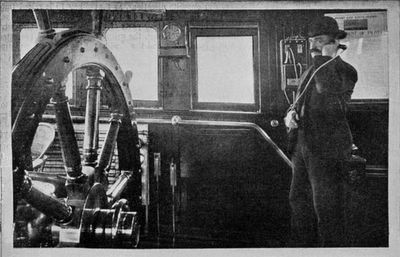
Fessenden Submarine Oscillator (Source: NOAA)
In 1914 the Fessenden Oscillator was invented by Dr. Reginald Fessenden of the Submarine Signal Company in order to communicate between ships and between ships and shore facilities. The above photo is demonstrating a listening device, very similar to a telephone, used on board ships as part of Dr. Fessenden's system.
Additionally if your interested in doing some sonar watchstanding check out the following quick google of links:
NOAA Vents program Acoustic Monitoring.
Whale Acoustics research company's ocean sounds page.
J & A Enterprises, Inc. Noise and Vibration Control Engineers ocean sounds page.
And a large historical collection at the HNSA-Historic Naval Sound and Video webpage.
Finally a bit of computer geek trivia on the PING command, who knew it had anything to do with sonar.
Back in a week. -LL
Wednesday, November 23, 2005
Israel's MAD Dolphins
The Dolphin class is designed for interdiction, surveillance and special-forces operations with torpedo and cruise missile weapons capabilities.

Dolphin Class Submarine
Specifications
Crew - 30 - 35
Displacement, surfaced - 1,640 tons surfaced , 1,720-1900 [est] submerged
Length - 57.3 m (188ft)
Beam - 6.8 m (22.6ft)
Dived speed - 20 knots
Operating Depth - Deeper than 200m (600 feet)
Cruise Range - 8,000 miles surfaced, 400 miles submerged
Weapons capacity - 16 surface to surface missiles or torpedoes
Sensors - PRS-3 passive ranging sonar, kollmorgen periscopes
Propulsion - three 16v mtu 396 se 84 diesel engines, single screw.
These new Dolphin submarines will be equipped with an air-independent propulsion (AIP) system not on Israel's current submarine inventory. This system would significantly increase the subs submerged range and stealth.
It is rumored that Israel in 2002 off Sri Lanka tested a nuclear-capable version of the Popeye Turbo cruise missile from one of it's Dolphin Class submarines. This Submarine Launched Cruise Missile (SLCM) reported range was about 1,500 km, significantly larger then any other SLCM variant carried by Israeli subs.
The rumours concerning Israel's nuclear-capable cruise missiles had stalled these additional sales from Germany in 2003, as did Israeli reluctance over the price. The current deal is reported to be worth EUR 1 billion ($1.17 billion) for the two AIP-equipped SSK Dolphin Class submarines.
The $1.17 billion acquisition of these submarines constitutes a major outlay from the Israeli defense budget which was about $9.1 billion in 2003.
Why should Israel acquire modern SSKs?
One reason is the rise of terrorist organizations using sea piracy as a means of income and economic intimidation. The North Africa region around Somalia has seen recent pirate activity. Additionally the sea has been an avenue for terrorist attacks in Israel.
Three Middle Eastern countries also operate submarines in the region; Egypt, Pakistan and Iran of which Iran's government continues to be openly threatening to Israel.
It's easy to speculate that with Iran's nuclear ambitions, stone walling of UN and EU nuclear inspections and continued support of terrorism, Germany has made a strategic decision here by going forward with the once stalled purchase. By providing Israel a weapons delivery platform that could provide a nuclear second strike capability they could be brokering a Middle East version of the old cold war MAD mutual assured destruction stalemate. This could also be seen as a way of putting pressure on Iran to cooperate with the IAEA.

Israel Map (Source CIA Fact Sheet)
The main Israeli submarine flotilla is based at the Mediterranean seaport of Haifa, but there is a Naval installation in the port of Eilat on the Red Sea. Eilat Naval base with it's Red Sea access would allow Israeli submarines to operate in the volatile Indian Ocean and Persian Gulf areas. The Eilat Naval Base is where the "Karine A" weapon smuggling freighter was taken after it was seized in January 3, 2002 by Israeli special forces.
If the news reports are correct and Israel does have nuclear weapons, it looks as though a sea based nuclear deterrent force is in the making.
Sunday, November 20, 2005
From Gettysburg to Fallujah – The Principles of Freedom
Please clear you head of all those old political arguments, either for or against the war in Iraq, and think of broader principles of freedom in the Middle East and the sacrifices of those fighting for that freedom as you read Lincoln’s words:
“Fourscore and seven years ago our fathers brought forth, upon this continent, a new nation, conceived in liberty and dedicated to the proposition that all men are created equal.
Now we are engaged in a great civil war, testing whether that nation, or any nation so conceived and so dedicated, can long endure. We are met on a great battlefield of that war. We have come to dedicate a portion of it, as a final resting place for those who died here, that the nation might live. This we may, in all propriety do. But in a larger sense, we cannot dedicate, we cannot consecrate, we cannot hallow, this ground. The brave men, living and dead, who struggled here, have hallowed it, far above our poor power to add or detract. The world will little note, nor long remember what we say here; while it can never forget what they did here.
It is rather for us the living, we here be dedicated to the great task remaining before us--that from these honored dead we take increased devotion to that cause for which they here gave the last full measure of devotion--that we here highly resolve that these dead shall not have died in vain, that this nation shall have a new birth of freedom, and that government of the people, by the people, for the people shall not perish from the earth."
Audio link to the Gettysburg Address read by actor Jeff Daniels.
I think the last paragraph in Lincoln’s address is an appropriate juxtaposing to Iraq in that we owe those who "gave the last full measure of devotion--that we here highly resolve that these dead shall not have died in vain, that this nation shall have a new birth of freedom".
Gettysburg is a quite place today because of those who sacrificed for freedom in Lincoln's time, and Fallujah, read what Greyhawk at The Mudville Gazette recently posted about progress in that city from a year ago.
Friday, November 18, 2005
Millblog Link to a Stg. in Iraq letter - Taste of Freedom
Puzzling Submarine Location
Click on the link, let the puzzle load, click and drag the pieces, start with the corners and then the sides.
Have fun and remember, putting a puzzle together doesn't have to be a race!
Update: OK, if you don't have the time here's the J.O. version it's easier.
Puzzle Location Solved: USS Providence (SSN719) inbound to NLON past Ledge Light.
Thursday, November 17, 2005
ASDS program afloat or sinking?
The answer may be yes, U.S Rep. Rob Simmons (R) of CT. say the ASDS program, under its current prime contractor Northrop Grumman, is 600 percent over budget and four years behind schedule. Simmons, who's district includes Groton CT home of the Electric Boat Company, has said the entire $1.2 billion program should be re-bid (Article in The Day registration required).
According to Simmons, Electric Boat's use of new production technologies in the Seawolf and Virginia class programs demonstrates the company's ability to develop advanced submarine systems and therefore should be considered as a possible contractor in any re-bid. As a member of the House Armed Services Committee Rep. Simmons has influence over such recommendations to the Navy and is pushing such a proposal publicly.
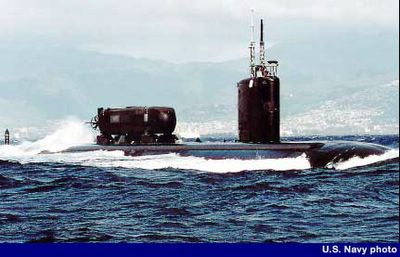
Advanced Seal Delivery System (Source: US Navy)
But not so fast, Democratic Sen. Barbara Mikulski of Maryland, says she has already won the fight to fully fund the program at $147.5 million for fiscal 2006. Ms. Mikulski serves on the Senate Appropriations Subcommittee on Defense. Reuters is also reporting that the prime contractor Northrop Grumman Corp. is upbeat on the Navy's ASDS mini-sub program.
Sen. Mikulski's district includes the Northrop Grumman's Bay Bridge plant in Annapolis where the ASDS is being developed. The plant could stand to get 150 new jobs if the $148 million contract is approved within the current spending package.
Ms. Mikulski has been appointed to a conference committee where the House and Senate will hash out differences in the bill before it goes to President Bush's desk.
Northrop Grumman hasn't had a good track record recently as I've noted here with submarines and here with surface ships.
It will be interesting to see if Rep. Simmons (R CT) can make a convincing enough argument to take the contract away from a defense contractor and a Senator with more political clout than budget sense.
Wednesday, November 16, 2005
A Diggit with Onions
"Life In The Navy Rocks Even Harder Than The Commercial Implied"
Man, skimmers white hats really have cool jobs. All we did on Boomer subs was field day and run WSRT and SCAM drills. Then again, us bubbleheads did get some occasional background music played by some Senior Chief pickin he's teeth.
Monday, November 14, 2005
Singapore's Submarines
Singapore has recently signed a contract to purchase two SSK Vastergotland-class submarines from the Royal Swedish Navy with the Swedish shipbuilder Kockums AB modernizing the subs and making modifications for operation in tropical waters. These two submarines are likely to replace two of the older Challenger submarines. In service date after modification is expected to be before 2010.
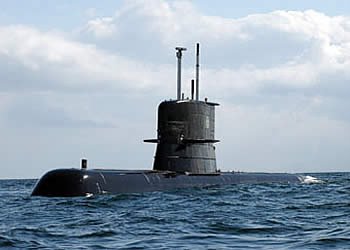
Vastergotland Class Submarine
Why does country as small as Singapore need modern SSK submarines?
Both of Singapore's neighbors have submarines or plans to purchase SSKs, Indonesia has two Cakra-class Type 209 subs and Malaysia has planned to purchase two Scorpene SSKs. But the real reason is that Singapore sits at the bottom of the Malacca Strait the single biggest chokepoint in the far east for shipping traffic including oil shipments to the energy hungry industrial economies of China, Taiwan, Japan and Korea. The Phillips Channel near Singapore is only 1.5 nautical miles (2.8 km) wide at its narrowest point. Singapore's economy is dependent on this shipping with exports of an estimated $174 billion in 2004. The country's merchant marine consists of 923 ships ranging in type from bulk carriers and container ships to petroleum and LNG tankers.
The Malacca Strait has been a hotbed of piracy and Indonesia, bordering the strait, has seen Al-Qaida sponsored terrorism. These two factors also contribute to Singapore's determination to keep a strong and modern naval presence (including submarines) in the Malacca Straits. This relationship between piracy and terrorism has also prompted Lloyd's of London to treat the threat of piracy as a war risk and subsequently change its rates.
When it comes to intelligence gathering on pirate activities, there is a question on whether submarines could be a political liability in the Malacca Strait. Because all Southeast Asian nations would have to be in agreement on the use of submarines the advantage a submarine may have in it's stealth could be compromised by agreements regarding operating restrictions. Most pirates are operating out of sheltered coastal coves, a foreign submarine continually operating in a disputed territory could touch a nerve between neighboring countries.
After reading this post and comments over at Chapomatic started by commissar post at The Politburo Diktat I thought it an interesting correlation between Singapore's recent submarine purchase, it's neighbors similar ambitions and the problem of Terrorism and Piracy in the Malacca Straits.
Submarines may not be the complete answer against pirates in the Malacca Straits or the Horn of Africa but they sure could take out a terrorist mothership if needed.
Thursday, November 10, 2005
1981 – Was My Waiter a Spy?
In the fall of 1981 on my first FBM patrol aboard the USS Simon Bolivar SSBN641(G), we had an equipment causality that necessitated us pulling into port for repair. That port was Bridgetown Barbados, not a bad place to make a liberty call. On the last day in port, a group of us went to a hotel on Paradise Beach. They had a nice bar on the beach and it seemed to be the place to relax, enjoy some reggae music and drink Banks beer.
About four of us were sitting at a table just off the beach within sight of the bar. We had a few rounds before finding out that the band wasn’t going to start for an hour or so. My shipmates were getting board and had decided to take a walk down the beach to check out the bikini scenery. Being the submarine non-qual and lightweight drinker of the group, I stayed behind to finish my beer.
The friendly waiter who had been serving us that afternoon was going off shift and stopped to see if my friends were returning and if I needed anything. Then he struck up what was at first an innocent conversation. I recall it went something like this:
Waiter – “Are you from the submarine over there in the harbor?” pointing in the direction of Bridgetown.
LL – “Yes, we’ve been in port a few days for a liberty call.”
Waiter – Sits down across from me “I’ve traveled on ships but I’d like to know what it’s like being on a submarine, how long do you stay at sea?” expressing what appeared to be a general curiosity.
LL – “This is my first time at sea; we’re supposed to do around 70 days a patrol.”
Waiter – After a few are fairly long general questions he picks up the pace, “If someone gets sick, do you have a doctor on board?”, “What’s the food like?”
LL – The questions he’s asking seem to be harmless enough so I answered the best I could for someone new to submarines. “We have a corpsman to handle emergencies.”, “The food is good but you run out of fresh milk and produce about two weeks out.”
Waiter – The next two questions came fast and without pause “You’re a missile submarine do you carry the Poseidon or Trident C4?”, “What is the range of the C4 missile?”
LL – Even with a few beers in me, this stopped me in my tracks. To the first question about the type of missile we carried, I just looked at him and didn’t say anything. On the second question about the C4 Missile range, I shook my head “NO” and did not say another word.
My “friend” the waiter looked upset with my non-answer and quickly left without saying anything. Just then, my shipmates returned no longer board after a successful bikini-scouting mission.
I don’t know if I just didn’t recognize what had just happened or being new to the real Navy felt too scared to relate my five-minute conversation with a waiter to the duty officer, but I never reported it. In either case, I should have reported what had occurred.
I relate this story as a sort of lesson leaned because if that waiter was an intelligence agent I could have made a serious mistake in not reporting my unease with what had happened. I didn’t disclose classified information but, if the waiter was an agent, by reporting the incident, I could have compromised his status.
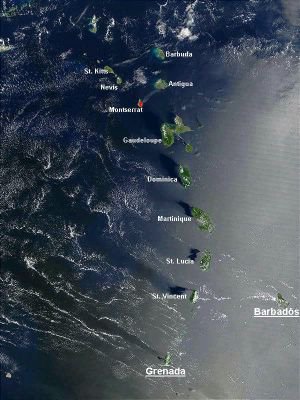
Lesser Antillies (Source: NASA)
You see that was late in 1981 and Barbados is in close proximity to Grenada. After President Reagan's 1982 visit to Barbados, he voiced a fear that Grenada, with its socialist government and proximity to Cuba, could become a Communist beachhead in the Caribbean. In October of 1983 Operation Urgent Fury was launched, after a request by the Organisation of Eastern Caribbean States (OECS), to stop the bloody seizure of power by a hard-line Marxist group in Grenada. It was believed that the Cubans were behind a government coup in Grenada and their agents had been operating for years on the islands around Grenada. Barbados was one of the island nations with great concerns about it’s neighbor's political direction.
Maybe my waiter was a spy maybe he wasn’t, but I wasn’t the one to make that determination. In any case if you’re active duty and someone is asking you questions that start off innocent but become progressively closer to what should remain unsaid be wary and let your command know of your suspicions.
Some things that seem simple or inconsequential at the time could actually mean something later on, you never know.
Sunday, November 06, 2005
Chinese Spies - Damn they're everywhere!
Chinese spies have been very active of late, lets do a little news run down:
Belgium and Greater Europe - The Telegraph, China aims spy network at trade secrets in Europe.
Canada - CBC news, Defectors say China running 1,000 spies in Canada.
Japan - The China Post, Who's spying now?
Russia - The Daily Telegraph, Official charged with spying for Beijing.
Sweden - The Local, China "suspected of spying at Swedish universities".
United States - Strategy Page, The FBI and the Chinese Spy Army.
Via the Internet 1 - NetworkWorld.com, Communist China spying via the ‘Net?
Via the Internet 2 - Australian IT, Worms do China's spying.
Via the Internet 3 - Washington Post, Hackers Attack Via Chinese Web Sites .
How difficult is it to track a Chinese national if they were involved in espionage?
According to the FBI and U.S. Immigration, cultural and economic exchange between the United States and China results in about 150,000 Chinese students studying at U.S. Universities and about 700,000 Chinese tourists and business executives visiting the U.S. each year.
China may be a valued trading partner but they don't have our interests in mind, in fact, much to the contrary.
The Media Line - IRAN LAUNCHES FIRST SPY SATELLITE (Chinese-made satellite)
Persian Journal - The Chinese Communist Party Won Iran's "Election".
The Washington Post - China Tells Congress To Back Off Businesses.
The Washington Times - China may attack Taiwan in two years: Pentagon.
Science Daily - Chavez may sell F-16 planes to China, Cuba.
The Heritage Foundation - Balancing China's Growing Influence in Latin America.
Everyone spy's, but with this much activity being reported in the press it's got me wondering, are the Chinese bad at the espionage business or is their operation so large that they can afford to have a few get caught? I'm thinking the latter....
Friday, November 04, 2005
MilBlogging With Open Source Information
So here's the question:
How difficult is it to prevent writing something that, although open sourced, could compromise the security of what the Milblogger holds dear, their country and service?
Intelligence is more than covertly obtained secrets, more times than not is a mosaic of information pieced together to create a picture of the capability, direction or intent of an adversary. Collecting intelligence into this mosaic can come from a number of places, some covert; satellite imagery, signals/communication intercepts, human intel or overt such as simply reading the news and professional journals "Open Sources".
Open Sourced Intelligence
In a recent CIA unclassified paper by CIA Analyst Stephen C. Mercado titled "Reexamining the Distinction Between Open Information and Secrets" the author argues that open sources often equal or surpass classified information. He also contends that the Intelligence Community (IC) needs to assign greater resources to open source intelligence (OSINT), stating that OSINT’s share of the overall intelligence budget has been estimated at roughly 1 percent but provides anywhere from 35 to 95 percent of the intelligence used in the government.
So are Milbloggers acting as journalists or a disassociated network of OSINT collectors unknowingly aggregating information for an adversary or unfriendly nation?
Overt and covert sources of intelligence are sometimes one in the same when leaked information makes it to the public sector. A prime example is the below K-11 spy satellite photo taken 1984 of an under-construction Soviet aircraft carrier. Later in the following year that classified photo appeared in the professional journal Jane's Defence Weekly exposing and therefore compromising a key US overhead imagery intelligence (IMINT) capability.

K-11 Spy Satellite Photo of Nikolaiev 444 shipyard in the Black Sea 1984.
(Public Domain Sourced: National Reconnaissance Office via Wikipedia)
Today I can get open sourced satellite imagery approaching the 1984 K-11 leaked photo. The below image is of Electric Boat shipyard in Groton, CT where submarines are constructed. The terrserver website provides two additional levels of magnification than I posted here.
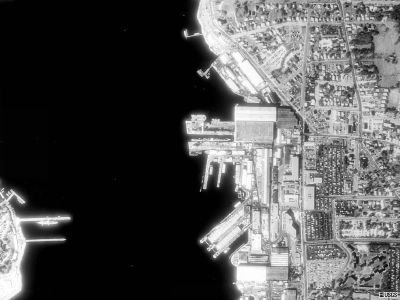
Electric Boat Shipyard- 4/1991 (Open Sourced: USGS via terraserver-usa.com)
If I annotated the above photo with additional information pertinent to a news event at the shipyard am I blogging as a journalist? What if I added some personal, though unclassified, insight into that event. Could I become an OSINT source with this additional and unique information added, probably.
Open Source Value
Mr. Mercado argues the OSINT at times provides a better value than covert intel in terms of speed, quantity, quality, clarity, ease of use, and cost. He sites bloggers as one open source that fits the better value "Open Source" criteria.
The Milblogger has a conflict here for all the things that makes his site worth reading are exactly what makes it a value as a OSINT source. In the zeal to provide interesting content, the Milblogger could cross that fuzzy line of what is of value to a reader who is not friendly. Without knowing exactly what knowledge this unfriendly reader is seeking it's impossible to defend against.
Crossing the Line into Classified Info
For many military personnel serving in Iraq and Afghanistan blogs have become a more efficient way to share the intensity of their experience. But writing about their experiences in a war zone the Milblogger has to be extra careful not to divulge tactics, techniques, system vulnerabilities, operations, methods, etc.
Milblogs have leaked classified information and the military has disciplined some service members. In August 2005, an Arizona National Guardsman on active duty in Baghdad was demoted and fined for publishing classified information on his personal blog.
The Army in particular has seen blogs as a serious "loss lips sink ships" kind of problem.
Conclusion
Aside from being difficult problem, I don't see a clear answer on how to the mitigate the risk posed by open sourced information. Our society’s freedoms are based on the free flow of ideas, apart from clearly defined state secrets; an effective model of self-censorship for Milblogs isn't available. After all even without Milblogs most of the information is open to the public, just not assembled in one place and easy to find.
Of course, other countries are far less tolerant of blogs, even one that covers a topic that has nothing to do with the military.
Update 11/9/05 22:00 : As a prime example of exercising discretion in what you post and being diligent in preventing the inadvertent disclosure of sensitive information, MT1(SS) over at Four Knots to Nowhere seems to have caught a breach. He's reporting the sensitive info is already down from the offending site. Bravo Zulu!
Sunday, October 30, 2005
More Virginia Class Design and Concept Info
The below photo of the Virginia during construction has three holes circled where a new fiber optic Lightweight Wide Aperture Array (LWAA) is to go.
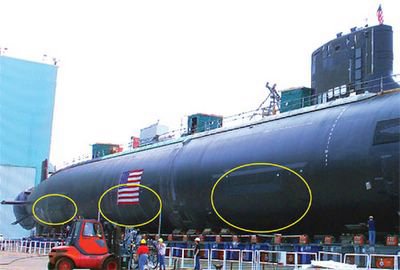
USS Virginia (Source: US Navy - NRL)
The system is the first fiber optic surveillance grade acoustic sensor system on an operational platform. Information can be found on the system's development from 1980's to production in 2000 at the Office of Naval Research, Naval Research Laboratory Review 2004 - "Development of the Fiber Optic Wide Aperture Array: From Initial Development to Production". Six sonar arrays three per side composed of Lasers and Fiber Optics translates to high bandwidth, I would think.
For a taste of how some of the consoles may function and integrate with other systems, I found this article from Undersea Warfare Magazine Fall of 2000 on the USS Virginia's Onboard Team Trainer Master Controller (OBTT MC).

OBTT Prototype (Source: US Navy)
The onboard simulation system will be capable of supporting a whole host of contacts including up to:
• 10 Medium Frequency Active (MFA) and Passive Sonar Contacts.
• 20 High Frequency Active (HFA) Sonar Contacts.
• 20 Tactical Weapon Simulator (TWS) Contacts.
• 35 Imaging Contacts (Visual/Infrared).
• 128 ESM Contacts.
• 10 Radar Contacts, and
• 8 stored harbor models for ingress and egress training.
The system will also interface with the ships Communication suite simulating Over-the-Horizon/Global Command and Control System-Maritime (OTH/GCCS-M) communications.
The system uses of Commercial-off-the-Shelf (COTS) components to conduct onboard and at-sea simulated engagements comparable to those of a shore-based team trainer.
Conceptual info Video Links:
I did find some cool broadband streaming video over at the Lockheed Martin video gallery covering some of the concepts incorporated or proposed for the Virginia class submarine.
The first concept is leveraging Commercial-off-the-Shelf (COTS) components to increase adaptability and processing power. Link "Always the Leader"(5.53 MB .WMV)
Next is the idea of optimizing for a time sensitive target strike through a system called "Transformational Tactical Targeting". Key component of the concept is the GCCS-M mentioned above. Link "T3" (9.57 MB .WMV)
Finally the "Sea Talon" Submarine launched UUV for littoral areas. Link "Sea Talon" (9.19 MB .WMV)
Although none of video is of the interior of a Virginia class sub they do provide a look into some of the concepts incorporated in that class of submarine. I also have to say Lockheed Martin has a slick marketing department, lots of cool stock submarine footage and a forceful narration to put their concepts and products forward.
Saturday, October 29, 2005
Post Brac Mini-Boom at PNS
Well apparently, PNS is undergoing a mini-boom in jobs, from the New Hampshire Union Leader:
Shipyard commander Capt. Jonathan Iverson said the current work force must grow by 300 people a year to be able to handle the submarine overhaul and maintenance projects that are scheduled.
“For the next four years, we’re chock-a-block full of work,” he said. “With the increased workload, we’re looking to bring more people on.”
Looks like Brac made the right decision in keeping PNS open.
Thursday, October 27, 2005
An Un-Conventionally Armed SSBN
In the October issue of Proceedings magazine author Norman Polmar writes in his article "Strategic Submarine Progress" (not currently available on-line) about some unconventional thinking relating to Submarine Launched Ballistic Missiles or SLBMs.

Trident II D5 Missile (Source: US Navy)
The unconventional thinking is put forth by the Defense Science Board and it is to arm some SLBMs with conventional (non-nuclear) warheads. The proposal pertains to the converted Trident SSGNs and recommends retaining some SLBM capacity. Rear Admiral Charles B. Young, Director of Strategic Systems Programs was quoted in Aerospace Daily & Defense Report, 17 June 2005 as saying a SLBM could deliver 1,250 pounds of conventional explosive to a range of 1,500 nautical miles, adding "Time of flight would be about 14 to 15 minutes... So if you have a time-critical target, that is a great capability".
The idea is that a conventional warhead's accuracy could also be enhanced to less than 30 feet with the addition of a global positioning system GPS guidance package. There is also some speculation in Polmar's Proceeding article that if the Navy were to pursue a conventional-warhead Trident missile they may consider arming Trident SSBNs in addition to or instead of SSGNs.
Although I don't think such a proposal would be very cost effective, placing a 1000 lb bomb on a extremely expensive weapons system, it does have its merits. (Addition reading on merits at the Baker Institute in pdf)
First being the ability to place a conventional weapon on a time-critical target from an extreme range. This would give the defense department a quick reaction option to an unanticipated region or situation where other assets could be hours if not days away. The caveat here being that if the target is unanticipated how do you quickly and accurately communicate the targeting information to the submarine submerged and maybe 1500 nautical miles away.
A second benefit could be the shock and awe factor. A dictator or terrorist may feel the remoteness of his location or no clear nearby US military presents as a form of safety until his chemical weapons pilot-plant is destroyed by a warhead falling at something close to Mach in double digits. The kinetic energy release alone could scare the hell out someone standing within visual range. Additionally placing the idea in the head of a dictator that the next warhead could be in the kiloton range may be enough to instill a little behavior modification to the positive.
Third, the capability to deliver a conventional weapon from a great distance with extreme accuracy and within minutes could force hostile nations to either harden or decentralize their high value military assets. The tactic of hardening, hiding or building decentralized redundancy would be costly to a potential enemy and may result in reduced command and control of those assets. The only other option for them would be to build or buy an Anti Ballistic Missile (ABM) system. This could also draw funds and skilled personnel away from the offensive weapons systems that we are more concerned about.
Lastly, the conventional SLBM warhead could be a way of prototyping and testing technology and designs to be later adapted for nuclear warheads. Such technologies could include the aforementioned improved accuracy with GPS as well as bunker busting earth penetrating munitions.
Apart from the cost, numbers of conventionally armed SLBMs would be limited because it would compete with the traditional SSBN role. A SLBM with a conventional warhead would also not be an option where an adversary is a known nuclear power with ICBM and or SLBM capability. A conventional strike could be mistaken for a nuclear one and invoke a nuclear response. Additionally such a weapon would complicate any future arms limitation talks with said powers.
The Navy has rejected this idea in the past but with the advent of the Trident conversions to SSGNs the concept may be given another look.
Video link for Missile one away, Missile two away (mpg 4.1mg).....
Tuesday, October 25, 2005
Toshiba and Russian Espionage – Again
It is also alleged that the Project 671RTMK Victor III subs incorporated a fully integrated submarine combat direction and fire control command system that ran on computers obtained from the Toshiba Corporation of Japan. This fire control system is said to be based on one developed for the Norwegian Ula class submarines.
So in recent news here and here, a Japanese employee of Toshiba Corporation has been caught selling confidential data to a Russian official. The leaked data referred to semiconductor technologies that could be used for jet fighter radar, missile guidance systems and submarine periscopes.
Industrial espionage is as much a national security risk as the Walker spy ring or those identified in the Cox Report.
Saturday, October 22, 2005
Where Were You? Remembering Beirut 10/23/1983
On October 23, 1983 in Beirut Lebanon a truck laden with the equivalent of 12,000 pounds of TNT crashed through a gate and into the lobby of the Marine headquarters building. The suicide bomber then detonated his explosives killing 241 American servicemen: 220 Marines, 18 Navy personnel, and 3 Army soldiers.
That was and remains the largest single day death toll of US Marines since WWII. The public response by the Reagan Administration was that it pledged to maintain a military peacekeeping force in Lebanon. A plan was drawn up to attack a barracks in Lebanon that housed the Iranian Revolutionary Guards believed to have been training Hezbollah fighters responsible for the attack. The Battleship New Jersey was moved off the coast of Lebanon and even shelled some suspected terrorist camps.
Worries about reactions from "friendly" Arab nations prevented the Reagan administration from taking any overly aggressive action, therefore canceling the planned targeting of the Iranian Revolutionary Guards barracks. The International Peacekeeping force was eventually withdrawn and Lebanon descended further into civil war and chaos. Probably the Reagan Administration's biggest mistake and a victory for the purveyors of terrorism in the Middle East.
Where was I
I heard the news of the Marine barracks bombing while on patrol on the USS Simon Bolivar SSBN 641 Gold.
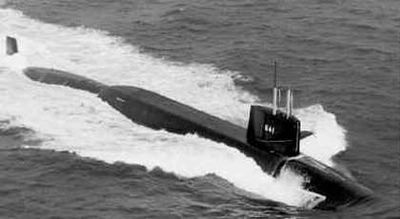
USS Simon Bolivar SSBN 641 (Source: US Navy)
A couple weeks later the Bolivar was nearing the end of it's 70 day patrol and was given new orders, "Liberty Call", but where?
The USS Simon Bolivar in 1983 was one of the few C4 Trident Missile Backfit boats and being a boomer, liberty port calls during a strategic deterrent patrol were very rare. Additionally most port calls for boomers were limited to relatively friendly places, Port Canaveral FL, Halifax Nova Scotia, places like that. With few exceptions, countries didn't like Nuclear Powered Submarines with Nuclear Weapons capability sitting in one of their ports. But we were on the other side of the Atlantic from any of those "regular" liberty ports so where were we going especally with the 1980's anti-US and Reagan climit in Europe and ongoing terrorism.
Our port visit was, Agadir Morocco, in North Africa. According to the CIA factbook Morocco is 98% Sunni Muslim, maybe not the place to send a Ballistic Missile Submarine after a terrorist attack, especially in light of recent history.
Conclusion
Twenty two years later I may be reading more into the coincidence of a my rare SSBN North African port visit and the Beirut bombing. I had great respect for Ronald Reagan and would like to think that someone in his Administration wanted to send a message to any possible State sponsor of terrorism that the US had other options within the range on an SLBM for a trouble making Middle Eastern nation. Of course today there are still those who can't leave Lebanon to the Lebanese people.
More information about the Beirut Marine barracks bombing can be found at the Memorial site or Alington Cemetery site.
Thursday, October 20, 2005
Submarines of Rhode Island
Here's a few photos of submarines with some association to my home state, Rhode Island.

USS Rhode Island SSBN 740 (Source: US Navy)
If you've ever been to my home state you'll recognize the bridge behind the sub as the Newport Bridge. The USS Rhode Island, accompanied by the Sloop Providence, is exiting Narragansett Bay and would have passed by the Naval War College before going under the bridge. Photo was probably taken shortly after commissioning in 1994.
Update 10/22/05: Ooops, a second look at the photo above and I realize I got it backwards, they're going up the bay not leaving.

USS Providence SSN 719 (Source: US Navy)
Photo is of the USS Providence SSN 719 named for the capital city of Rhode Island, is the fifth warship in Naval History to bear the name. The Providence is a Flight III boat, the first of the 688's with the Vertical Launch System (VLS) installed. Photo was taken during sea trials somewhere off the Southern New England coast.
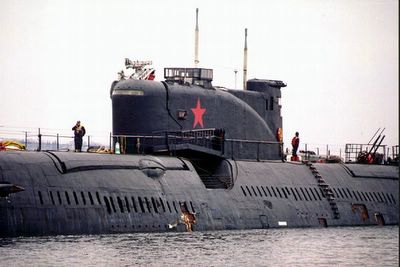
Juliett 484 K-77 (Source: Saratoga Museum Foundation)
The Juliett 484 is a 300-foot long, diesel-powered Cold War veteran, moored at Collier Point Park in Providence, Rhode Island. The sub is the centerpiece of The Russian Submarine museum run by the Saratoga Museum Foundation and is open to the public.
Tuesday, October 18, 2005
UK Could Extend Vanguard SSBN Lifespan.
From The Herald in the UK "Trident fleet faces stretched lifespan to help curb defence costs"
(Hat tip: NOSI - Naval Open Source Intelligence)
BRITAIN is to try to stretch the operational lifespan of its four Trident missile submarines until at least 2035 to maintain its nuclear deterrent at minimal cost and risk, according to naval sources.
Tony Blair and John Reid, defence secretary, have both insisted recently that no decisions have been taken, but sources say they have already scrapped alternative plans for aircraft or submarine-launched cruise missiles tipped with nuclear warheads.
They have also rejected building a new generation of submarines despite the fact that replacing ageing intercontinental missiles, installing new reactor cores, and redesigning the existing British warheads could cost more than the original £12.2bn paid for the Trident system in the 1990s.

Royal Navy Vanguard SSBN
The lead UK boat is the HMS Vanguard commissioned in 1993. If the lifespan of this class is extended to 2035 this would put it in the same timeframe for replacement as the US Tridents. The last US Trident commissioned was the USS Louisiana SSBN 743 on 9/06/1997.
As of this date, there is no large-scale design or production program in place by either country to replace thier Trident Submarines. The development of a SSBN-X Follow-on to the Trident should start in the next 10 years. This is in order to replace the first of the Tridents to be decommissioned in approximately 2029.
Monday, October 17, 2005
Beer and Submarines - odd google finds
Dutch beer commercial for a Walrus -- Video link -- drink up.
Brit sub layout with Food/Beer storage area.
Beer recovered from the S/S Nicomedia a victim of the The Submarine Massacre of 1915 was reproduced in 2000 and sold as "Wreck Beer" by a Swedish brewery.
A beer and a shot is known as "depth charge" at the following watering holes.
The Submarine Cocktail from Mexico.
Cold beer and Nazi subs in Chicago?
Four from the USS Dace (SSN-604) go through 62 gallons of beer, you'll find at the end of a rather long photo description.
Submarine and Luau Combination with open bar!
AND to sober everyone up read the story of Chris Beer age 18 who wanted to be a RAN submariner. Makes you want to think before you drink.
Saturday, October 15, 2005
Alvin (DSV-2) to Start Last Refit
Alvin routinely undergoes a refit about every 3 years where it is completely disassembled down to the (1.9 in.) thick titanium personnel sphere. The DSV recently returned on 10/13 to Woods Hole, MA aboard it's support vessel R/V Atlantis from the Pacific.
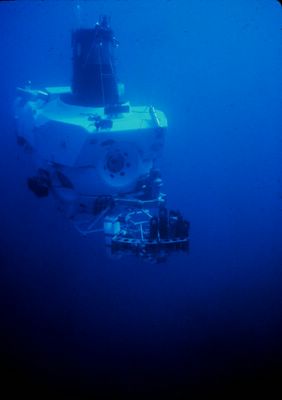
Alvin Submerged (Source: NOAA)
The submersible Alvin is owned by the US Navy and operated by WHOI as a national oceanographic facility. The DSV typically makes eight-hour dives transporting two scientists and a pilot as deep as 4,500 meters or 14,764 feet. Specifications on the DSV can be found here.
Alvin has made more than 4,100 dives worldwide in it's forty year history. Of those dives the majority have been for Biology, Geology and Geophysics research. A NOAA streaming video of Alvin being launched from the support ship R/V Atlantis can be found here.
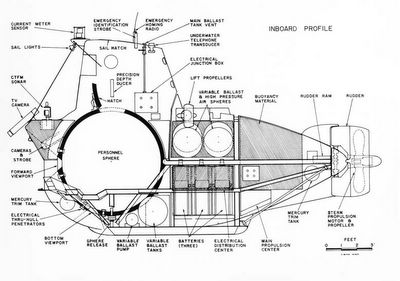
Alvin Drawing (Source: NOAA) Click on graphic for larger view.
Alvin is famous as the Geophysics research vehicle that in 1977 discovered the first hydrothermal vents off the coast of the Galapagos Islands. That discovery lead researchers to about 300 new species of animals, including bacteria, foot-long clams and mussels, tiny shrimp, arthropods, and red-tipped tube worms that can grow up to 10 ft long in some vents. The biological significance being that these creatures were the first discovered to exist totally independent of sunlight for energy and therefore an ecosystem dependent upon the these deep sea hydrothermal vents.
Other significant discoveries, accomplishments and mishaps in Alvin's 40 year history include:
1966 - Alvin assisting in the recovery of a hydrogen bomb lost when the B-52 crashed in the Mediterranean off Palomares, Spain after colliding with a refueling tanker.
1967 - Alvin was attacked by a swordfish on the bottom at about 2,000 feet. The fish became trapped in Alvin’s skin and was brought back to the surface (and cooked for dinner).
1968 - Alvin’s cradle support cables failed and Alvin slid into the water and sank to the bottom in 5,000 feet of water. The pilot sustained minor injuries and escaped while the sub was on the surface. Alvin was recovered a few months later with the assistance of the DSV Aluminaut .
1977 - Alvin discovered the first hydrothermal vents off the coast of the Galapagos Islands.
1980 - Alvin completed its 1,000th dive at the Galapagos Rift
1986 - Alvin made 12 dives to the RMS Titanic to test a prototype robotic vehicle called Jason Jr. and to photographically document the wreck.
A full chronology of Alvin's history can be found here.
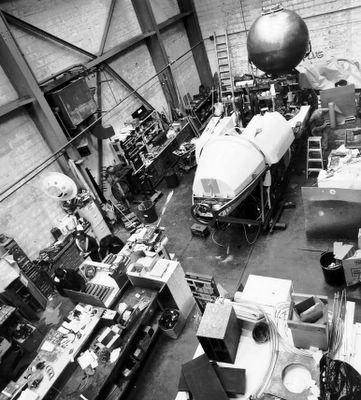
Photo of 1974 refit of Alvin where a (1.9 in.) thick titanium pressure sphere replaced the HY-100 steel one, increasing it's certified dive depth (Source: NOAA)
Alvin's pilots typically have engineering degrees. Pilot certification is in some ways like earning your Submarine Dolphins, the U.S. Navy requires pilots to draw—from memory—dozens of the sub’s intricate hydraulic, ballast, electrical, and mechanical components and systems. Alvin's pilots are skilled swimmers assisting in every launch and recovery of the DSV. Additionally they are all mechanics as well as pilots; being required to make shipboard repairs during an expedition.
The sub's name Alvin is in honor of the prime mover and creative inspiration for the vehicle, Allyn Vine, a scientist at Woods Hole Oceanographic Institution. A 2004 NPR audio interview is linked here with Barrie Walden, manager, National Deep Submergence facility at the Woods Hole Oceanographic Institution on Alvin' s projected retirement.
Monday, October 10, 2005
Who was Josef Papp?
Papp claimed to have built a unique jet propulsion and engine system that drove his home built submarine at such a high speed that it was enveloped in a bubble of air or supercavitation. He even wrote a book about the submarine's design, construction and sea trial titled "The Fastest Submarine".
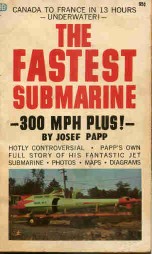
The Fastest Submarine?
Papp's story is so fantastic that has been placed in the realm of hoaxes and frauds.
On August 11, 1966, after being missing for a few days from his home in Canada, Joseph Papp was picked up from a life raft by a fishing boat off Brest, France. Bruised, bloodied and dressed in a flight helmet and goggles Papp claims to have just bailed out of his high-speed experimental submarine. When questioned further Papp explains that he had traveled in his sub across the Atlantic solo and in just 13 hours. According to Papp, the submarine had become unstable during the voyage and after he bailed out it sank never to be found.
With no real evidence of his fantastic feat and two round trip plane tickets to France found in his pocket, Papp was quickly dismissed as a prankster.
Josef Papp who died in 1989, was described as an extremely paranoid, very unstable, selfish, and unpredictable man. But this odd man's life has other interesting controversies besides his submarine adventure. Papp was an inventor holding three US patents: "Method and Means for Generating Explosive Forces", "Method and Means of Converting Atomic Energy into Utilizable Kinetic Energy" and "Inert Gas Fuel, Fuel Preparation Apparatus and System for Extracting Useful Work from the Fuel". Joseph Papp's Noble Gas Engine is another fraud that may or may not be a fraud.
Just goes to show you, anyone interested in submarines and atomic energy may not have both oars in the water, but then again they may. Yet another unsolvable controversy ;-)
Saturday, October 08, 2005
Russian Submarine Launched Spacecraft - failures
Moscow, Russia (AHN) – Russian authorities are searching for an experimental mini-spacecraft today, just one day after the prototype was test launched from a nuclear submarine. A Russian news agency reports that engineers have had no contact with the Demonstrator spacecraft since its launch on Friday. No signals are being received from the craft. Workers have called off their search for the night and planned to resume at daybreak.
Previous submarine launch failures included a joint Russian-U.S project attempt at deploying the first controlled flight of a solar sail.
Today news includes another Russian failure of a converted land based ICBM launch with a European Space Agency's (ESA) Cryosat satellite aboard.
The Russians did have a successful launch today of a submarine missile with a different purpose in mind.
Thursday, October 06, 2005
Auto Airbag Torpedo Launcher
Sea Corp. a local company here in Rhode Island has developed and tested such a system in the past year. In the spring of 2004 the company tested such a system aboard the Martha’s Vineyard High Speed Ferry. During the five day test 31 launches were made of torpedo and countermeasure shapes at speeds up to 35 knots. Here’s a link to their R&D page describing their Advanced Surface Launcher (ASL) system’s development. Also on the page there is a streaming video of one of their test launches (Link here – warning loads slow about a minute with broadband).
When I watched the streaming video a few thoughts came to mind.
One was obviously that the system may be employed on the Navy’s new LCS (Fast Ferry ;-) class of ships under development. A second would be a possible method for celebrities to take out those annoying Paparazzi on their way to "The Vineyard". Lastly, the locals may need to take down a number of environmentally unfriendly structures proposed for Nantucket Sound that they seem to have a problem with.
Wednesday, October 05, 2005
Bioluminescent Organisms "Milk Sea"
Depending on the concentration of these glowing organisms, a ship's wake may be visible for up to 6 nautical miles. In 1918, it was bioluminescence that gave away the position of the last German U-boat sunk during World War I.
The Navy is therefore interested in studying bioluminescence and it's Naval Research Laboratory scientists recently confirmed the existence of a phenomenon known as a "Milk Sea".
There have been 235 documented sightings of milky seas since 1915 but up until now there has been no real photograpic evidence of bioluminescence on such a large scale. However, The Defense Meteorological Satellite Program has captured an image of a "milk sea" the size of Connecticut in the Indian Ocean off the coast of Somalia.

Milky Sea (Source: Naval Research Laboratory - Dr. Steven Miller)
A report in Live Science "Mystery Ocean Glow Confirmed in Satellite Photos" states the following:
Scientists suspect bioluminescent bacteria are behind the phenomenon. Such creatures produce a continuous glow, in contrast to the brief, bright flashes of light produced by "dinoflagellate" bioluminescent organims that are seen more commonly lighting up ship wakes and breaking waves.
"The problem with the bacteria hypothesis is that an extremely high concentration of bacteria must exist before they begin to produce light," Miller told LiveScience. "But what could possibly support the occurrence of such a large population?"
One idea, put forward by the lone research vessel to ever encounter a milky sea, is that the bacteria are not free-living, but instead are living off some local supporting "substrate."
"This previous excursion reported the presence of bioluminescent bacteria, which were found to be living in association with an algal bloom," Miller explained.
So it appears that a "Milk Sea" could be caused by high concentrations of bioluminescent bacteria independent of a disturbance, but what can be witnessed in a ship's wake are tiny bioluminescent organisms like jellyfish.

Bioluminescent Jellyfish (Source: NOAA)
The "Milk Sea" phenomenon is found primarily in the Indian Ocean, where as, bioluminescence can be found in all oceans throughout the world. Research into understanding bioluminescence and possibly forecasting it's occurrence could help US Submarines operating in littoral waters avoid detection as well as improve anti-submarine warfare against our adversaries.
